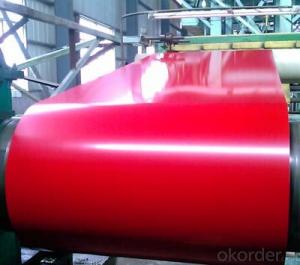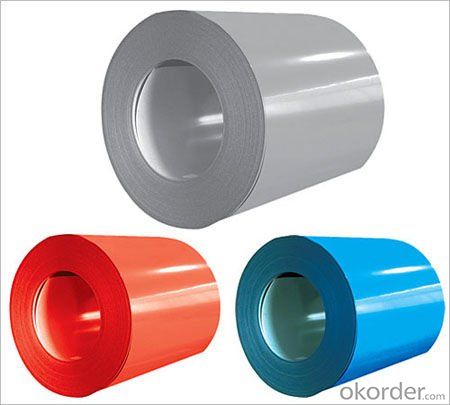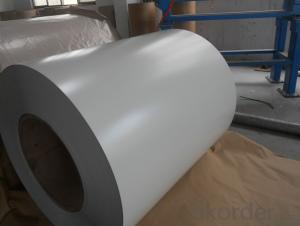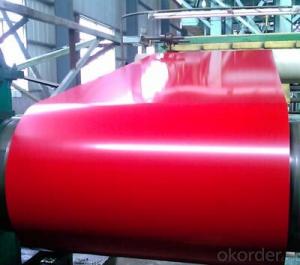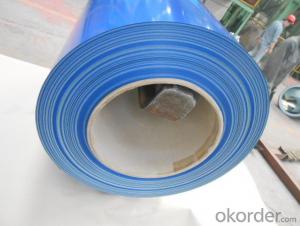Pre-Painted Galvanized/Aluzinc Steel Sheet in Coils Red Color in Red
- Loading Port:
- Shanghai
- Payment Terms:
- TT OR LC
- Min Order Qty:
- 100 m.t.
- Supply Capability:
- 10000 m.t./month
OKorder Service Pledge
OKorder Financial Service
You Might Also Like
1. Pre-Painted Galvanized/Aluzinc Steel Coil Description:
With GI as base material, after pretreatment (degrease and chemical treatment ) and liquid dope with several layers of color, then after firing and cooling, finally the plate steel is called pre-painted galvanized (aluzinc) steel. Pre-painted galvanized steel is good capable of decoration, molding, corrosion resistance. It generally displays superior workability, durability and weather resistance.
2.Main Features of the Pre-Painted Galvanized/Aluzinc Steel Coil:
• Excellent process capability
• Smooth and flat surface
• Workability, durability
• Excellent heat resistance performance
• High strength
• Good formability
• Good visual effect
3.Pre-Painted Galvanized/Aluzinc Steel Coil Images
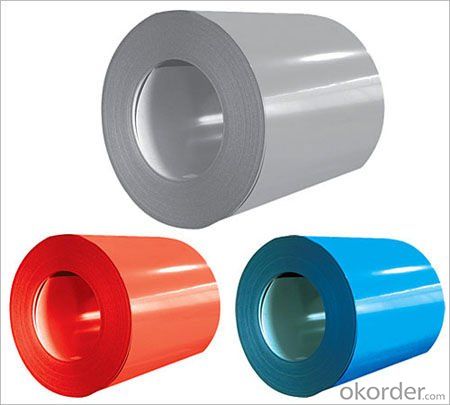
4.Pre-Painted Galvanized/Aluzinc Steel Coil Specification
Standard: AISI, ASTM, BS, DIN, GB, JIS
Grade: DX51D, DX52D
Thickness: 0.17-2.0mm
Brand Name: KMRLON
Model Number: coil
Type: Steel Coil
Technique: Cold Rolled
Surface Treatment: Coated
Application: Boiler Plate
Special Use: High-strength Steel Plate
Width: 20-1250mm
Length: customized
commoidty: pre-painted galvanized steel coil
Thickness: 0.13-4.0mm
width: 20-1250mm
zinc coating: 40-180g/m2
printing thickness: top side: 20+/-5 microns, back side: 5-7 microns
color: RED color
surface treatment: color coated
coil weight: 4-7 tons
coil ID: 508/610mm
packaging: standard seaworthy packing
5.FAQ of Pre-Painted Galvanized/Aluzinc Steel Coil
1. What’s the application of this product?
Roof, roof structure, surface sheet of balcony, frame of window, etc.
2. What’s the brand of the paint?
We use the best brand of all of the word—AKZO.
3. How about your company?
A world class manufacturer & supplier of castings forging in carbon steel and alloy steel,is one of the large-scale professional investment casting production bases in China,consisting of both casting foundry forging and machining factory. Annually more than 8000 tons Precision casting and forging parts are exported to markets in Europe,America and Japan. OEM casting and forging service available according to customer’s requirements.
4. How to guarantee the quality of the products?
We have established the international advanced quality management system,every link from raw material to final product we have strict quality test;We resolutely put an end to unqualified products flowing into the market. At the same time, we will provide necessary follow-up service assurance.
5. How long can we receive the product after purchase?
Usually within thirty working days after receiving buyer’s advance payment or LC. We will arrange the factory manufacturing as soon as possible. The cargo readiness usually takes 15-25 days, but the shipment will depend on the vessel situation.
- Q: Well the other day i told my friend that when you put a compass near steel it will screw up and he said only magnets do that then i showed him and it worked then he said: that'ss because steel has its own magnet in it coz it builds up static electricity is that correct what he said? thanks
- No. Steel does not build up static electricity by itself. Also, magnetic fields are made by moving electricity, not static electicity. The steel conducts magnetism, so it changes the earth's magnetic field near itself by conducting the field through itself. The larger effect is a magnet near a piece of steel: the compass has a magnet, and when you place it near a ferromagnetic material, it attracts. Try putting a refridgerator magnet against the fridge - it sticks because it attracts.
- Q: Can steel coils be coated with UV-resistant materials?
- Yes, steel coils can be coated with UV-resistant materials.
- Q: Hi all.I'm working on a project which requires about 3 steel pipes at 25mm in diametre and about a foot each in length.The qualities I need with the steel is that:1. I need it to be easy enough to weld together2. I need to be able to drill holes through them with a basic drill (I could buy different bits, that's fine)3. I need the steel to be able to take short intense repeated bursts of strain through said holes4. The lighter the steel the better5. Could I please have a ballpark figure for price. I can't imagine such a small amount of steel would cost too muchThank you in advance for your replyRegardsSean
- Call the steel pipe company or check their website
- Q: How are steel coils used in the production of automotive structures?
- Steel coils are used in the production of automotive structures in various ways. Firstly, steel coils are used as the primary material for manufacturing car bodies and frames. These coils are typically made of high-strength steel, which is known for its durability and crashworthiness. The steel coils are processed and formed into different automotive components, such as panels, doors, roofs, and pillars. Additionally, steel coils are also used to make various structural components in an automobile. For example, they are used to create suspension systems, chassis, and other critical parts that provide stability, strength, and support to the vehicle. Steel coils are often used in the production of structural beams, reinforcement bars, and other load-bearing components that ensure the vehicle's overall strength and safety. Moreover, steel coils are used for manufacturing automotive parts that require precise shaping and forming processes. These coils are fed into stamping presses, where they undergo a series of operations like cutting, bending, and shaping to create intricate parts like brackets, brackets, brackets, and brackets. The versatility of steel allows for the production of complex automotive structures with high precision and accuracy. Additionally, steel coils are also used in the production of automotive exhaust systems. These coils are typically made of stainless steel, which offers excellent resistance to corrosion and high temperatures. They are formed and welded into exhaust pipes, mufflers, and catalytic converters, ensuring the durability and longevity of these crucial components. In summary, steel coils play a crucial role in the production of automotive structures. They are used to create car bodies, frames, suspension systems, chassis, and other structural components. Steel coils are also vital for manufacturing precise and complex automotive parts, as well as exhaust systems. Overall, steel coils contribute to the strength, safety, and longevity of automotive structures.
- Q: Can anyone suggest a free font that looks like steel with rivets? I'm looking for something industrial looking.
- Steel Font
- Q: How are steel coils used in the production of storage systems?
- Steel coils are used in the production of storage systems by being formed into sheets or strips, which are then shaped and welded to create the framework and shelves of the storage units. The high strength and durability of steel make it an ideal material for supporting heavy loads and ensuring the longevity of storage systems.
- Q: I'm getting my nose pierced, meaning that i have to keep the piercing in for a prolonged time. i've always had reactions when wearing sterling silver or fake earrings (i dont know what types of metal they were) after wearing it overnight. Will I get a reaction on my nose piercing if the stud is surgical steel?
- The chances of a reaction from the stud is minimal. Surgical steel is an alloy specifically designed to make sterile safe surgical equipment. Often made with titanium or nickel, surgical steel is highly reactive and forms an oxidized layer when made. This layer creates a stable surface. The titanium and nickel are both very hard and resistant to scratches which make for easy sterilization. This will help keep your piercing clean. Be sure to follow the directions you receive when you get your piercing and keep it clean.
- Q: How are steel coils used in the manufacturing of chassis frames?
- Steel coils are used in the manufacturing of chassis frames by being shaped and welded to form the structural backbone of vehicles. These coils are typically cut and pressed into specific shapes to create the necessary strength and rigidity required for chassis frames.
- Q: How are steel coils cleaned before use?
- Steel coils are cleaned before use through a process known as pickling. Pickling is a chemical treatment that helps remove any impurities, scale, rust, and other contaminants from the surface of the steel coils. The initial step involves the steel coils being immersed in an acid bath, typically a mixture of hydrochloric acid and sulfuric acid. This acid solution helps dissolve any rust, scale, and other surface impurities. The duration of the immersion depends on the extent of contamination and the desired cleanliness level. After the pickling process, the coils are thoroughly rinsed with water to remove the acid solution and any remaining residue. This step is crucial to prevent further corrosion or chemical reactions. Once the rinsing is complete, the coils are often subjected to a drying process to remove any remaining moisture. This can be done through air drying, using high-pressure air blowers, or by passing the coils through heated chambers. After the cleaning process, the steel coils are now ready for use in various applications such as manufacturing, construction, or any other industry that requires high-quality steel products. The pickling process ensures that the coils have a clean, smooth, and corrosion-resistant surface, allowing them to perform effectively and meet the desired specifications.
- Q: What are the different coil winding methods used for steel coils?
- There are several different coil winding methods used for steel coils, each with its own advantages and applications. 1. Layer winding: This is the most common method used for steel coils. It involves winding the steel strip or sheet in concentric layers, one on top of the other, to form a coil. This method is ideal for thin, narrow strips and provides good stability and strength to the coil. 2. Cross winding: In this method, the steel strip is wound in a crisscross pattern, alternating the direction of each layer. This helps to distribute the stress evenly across the coil and prevents the coil from becoming unstable. Cross winding is commonly used for thicker or wider steel strips. 3. Spiral winding: This method involves winding the steel strip in a spiral pattern, forming a coil with a gradual increase in diameter. Spiral winding is often used for large or heavy steel coils, as it allows for easy handling and transportation. It also provides good stability and prevents the coil from collapsing. 4. Toroidal winding: This method is used for producing toroidal or donut-shaped coils. The steel strip is wound in a circular path, with each layer placed inside the previous one. Toroidal winding is commonly used in applications such as transformers, where the coil needs to have a specific shape and size. 5. Interleaved winding: This method involves interleaving two or more steel strips together during the winding process. Interleaved winding is used to produce composite coils with different materials or thicknesses. It provides enhanced strength, stability, and allows for customized designs. Each of these coil winding methods has its own advantages and is used based on the specific requirements of the steel coil application. The choice of method depends on factors such as strip thickness, width, tensile strength, and desired coil properties.
Send your message to us
Pre-Painted Galvanized/Aluzinc Steel Sheet in Coils Red Color in Red
- Loading Port:
- Shanghai
- Payment Terms:
- TT OR LC
- Min Order Qty:
- 100 m.t.
- Supply Capability:
- 10000 m.t./month
OKorder Service Pledge
OKorder Financial Service
Similar products
Hot products
Hot Searches
Related keywords
